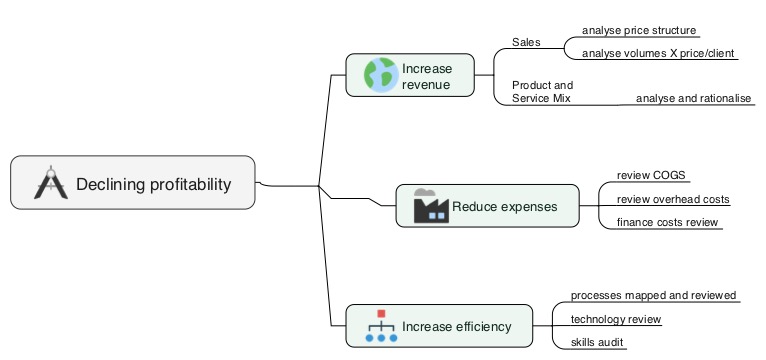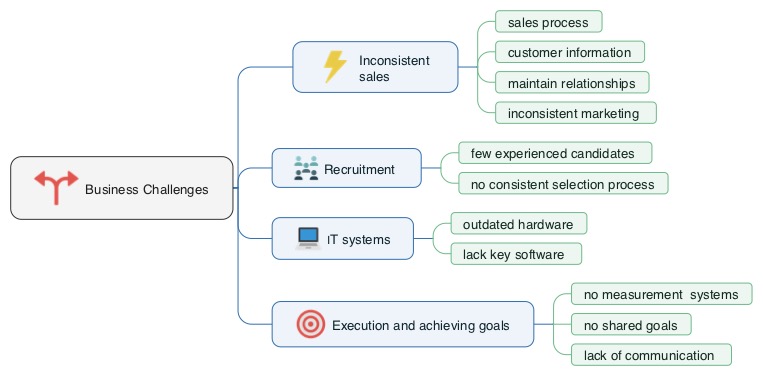How to create a value driver tree
The value driver tree is a tool used to identify the root cause of an issue. In our case it is used to identify causes of business issues. The value driver tree is also known as a fishbone analysis.
The value driver tree is a very useful model to use when engaging in discovery sessions with prospective and current clients. You should be familiar with the model so that you are able to use it in conversations as a way to structure thinking. The best use case is creating a value driver tree on a whiteboard, computer or paper flip-chart as part of the meeting with clients, prospects and internal stakeholders.

An example of a simple value driver tree is shown above. In this case the issue facing the business is declining profitability.
The next level to the right of the business issue breaks the issue of declining profitability down to three possible solutions. The third level are the actions needed to execute the solutions. A key concept when creating value driver trees is MECE.
The MECE model is used to separate items into subsets that are ‘mutually exclusive’ and ‘collectively exhaustive.’ The MECE model as developed by Barbara Minto at McKinsey and Company in the late 1960s. You can learn more here.
In some cases these actions may directly address the issue or be actions such as research and analysis. In the latter case, this may then lead to a further value driver tree created to reflect the outcomes of research and analysis.
A value driver tree must focus on one single issue. Therefore there may be a number of value driver trees created in the course of a discovery session. It is common to start the process with a value driver tree to determine which of a range of issue should be prioritised and then break that down to individual issues.

The example above shows a value driver tree that will then be broken down into the issue that is considered the highest priority.
The value driver tree helped my client remain focused and not go off in a number of different directions. In my consulting practice, I only focus on one issue per engagement. I have learned this removes the risks of project creep and uncertainty about closure of an engagement.
Once I have worked with my client to create a value driver tree on the challenge with the highest priority, there are two necessary steps before we commit to working together. The first step is gaining conceptual agreement. The process to this point is very positive for the client. Once the person is fully able to identify a business issue there is a sense of relief even before a solution is executed.
The positive state achieved in the value driver tree process is the precursor to conceptual agreement. The conceptual agreement is both parties agreeing that there is a compelling case for moving forward with an engagement to build and apply a solution to the business issue. The conceptual agreement is gained by asking the client whether they wish to solve this issue using you and/or your firm.
When this question is asked, there may be a few responses. One may be related to cost, another related to time, another related to decision making, etc. There is absolutely no point in developing a proposal with costs, activities and timelines until you have reached conceptual agreement with your client.
This is always very hard for my clients to accept. Most people in business to business professional services are using an outdated paradigm wherein the proposal is a huge document that is used to sell an engagement to a client or prospect. This is all wrong. The proposal I use includes seven sections and the whole document is rarely more than four to seven pages. I will cover more about proposals in another article.
For now let’s assume you gain conceptual agreement with the client or prospect. You are now ready to create your short proposal. What about the value driver tree?
The value driver tree is captured and saved. You photograph the whiteboard, photograph and roll up the flip-chart paper, save the digital file or whatever. The value driver tree is your navigation tool moving forward with the the engagement. The value driver tree will set the scope of the engagement as well as define the parameters of the activities that are going to be included in the engagement. I will cover more about using the value driver tree to develop your engagement plan in another article.
